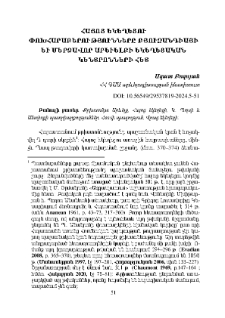Օբյեկտ
Վերնագիր: Հայոց եկեղեցու փոխհարաբերությունները Բյուզանդիայի և Մերձավոր Արեւելքի եկեղեցական կենտրոնների հետ
Ամսագրի կամ հրապարակման վերնագիր:
Արևելյան աղբյուրագիտություն = Восточное источниковедение = Studies in oriental sources
Հրապարակման ամսաթիվ:
Հատոր:
ISSN:
Լրացուցիչ տեղեկություն:
Այլ վերնագիր:
The Armenian Church's Relations With The Ecclesiastical Centres Of Byzantium And The Middle East
Համատեղ հեղինակները:
ՀՀ ԳԱԱ Արևելագիտության ինստիտուտ
Ծածկույթ:
Ամփոփում:
In his time John (Hovhannes) of Odzun (d. 728) proclaimmed that the hierarchical structure, theological conceptions and the rite of the Armenian Church were inherited from the time of the apostles. Along with the restoration of the public institutions in the Bagratid period (880s-1045), the Armenian authorities granted vast privileges to the Church, which turned into the most influential leverage for maintaining the inner and foreign policy of the state. In order to shatter the Bagratid Kingdom, the Byzantine Empire resorted to inciting conflicts between the Chalcedonian and anti-Chalcedonian Churches. Trying to subjugate Armenians and their territories at any cost, the Byzantine emperors weakened the religious structure of the Armenian Church. With the Seljuq raids of the 11th century we see that policy of Byzantium led to the Byzantine secession of the Minor Asian provinces where the Iconian Sultanate (or Sultanate of Rum, 1077-1308) and the Danishmandid State (1104-1178) were created by the Seljuq Turks. This continued with the gradual loss of the entire Minor Asian holdings of the Byzantine Empire and the emergence of the Ottoman Empire over the Byzantine territory. Finally the capital Constantinople was taken in 1453. The history of Armenian-Byzantine church relations shows that the mentioned churches had multifaceted religious and cultural relations. Over the centuries, they have made attempts to settle religious differences. In the process, each of them created a unique culture and civil system, the study of which allows us to understand their role in the modern world. To understand the characteristics of these cultures, detailed studies of ecclesiastical and literary monuments are assumed.
Հրատարակության վայրը:
Երևան
Ձևաչափ:
Նույնացուցիչ:
սեղմիր այստեղ կապին հետևելու համար ; oai:arar.sci.am:378575
Լեզու:
Բնօրինակի գտնվելու վայրը:
ՀՀ ԳԱԱ Հիմնարար գիտական գրադարան
Օբյեկտի հավաքածուներ:
Վերջին անգամ ձևափոխված:
Nov 4, 2024
Մեր գրադարանում է սկսած:
Oct 16, 2024
Օբյեկտի բովանդակության հարվածների քանակ:
103
Օբյեկտի բոլոր հասանելի տարբերակները:
https://arar.sci.am/publication/408458
Ցույց տուր նկարագրությունը RDF ձևաչափով:
Ցույց տուր նկարագրությունը OAI-PMH ձևաչափով։
-
Մատենաշարային և պարբերական հրատարակություններ
-
Օտար աղբյուրները Հայաստանի և հայերի մասին = Иноязычные источники об Армении и армянах
-
Հայ ազգագրություն և բանահյուսություն․ Նյութեր և ուսումնասիրություններ = Армянская этнография и фольклор. Материалы и исследования
-
Հնագիտական պեղումները Հայաստանում = Археологические раскопки в Армении
-
Հայաստանի հնագիտական հուշարձանները = Археологические памятники Армении
-
Դիվան հայ վիմագրության = Свод армянских надписей
-
Հայ ժողովրդական հեքիաթներ = Армянские народные сказки
-
Հայ ժողովրդի պատմություն = История армянского народа
-
Նյութեր հայ ժողովրդի պատմության = Материалы по истории армянского народа
-
Հայոց պատմության հարցեր = Вопросы истории Армении = The Problems of the History Of Armenia
-
Արևելագիտական ժողովածու = Востоковедческий сборник
-
Արևելյան աղբյուրագիտություն = Восточное источниковедение = Studies in oriental sources
-
Արևելյան աղբյուրագիտություն, 1988, 1
-
Արևելյան աղբյուրագիտություն, 2020, 2
-
Արևելյան աղբյուրագիտություն, 2022, 3
-
Արևելյան աղբյուրագիտություն, 2023, 4
-
Արևելյան աղբյուրագիտություն, 2024, 5
- Կազմ; Խմբագրական կազմ
- Armenian Writers In Medieval Jerusalem (6th–16th Centuries; Revised And Expanded)
- Հայոց եկեղեցու փոխհարաբերությունները Բյուզանդիայի և Մերձավոր Արեւելքի եկեղեցական կենտրոնների հետ
- Պատկերամարտական շարժման սկզբնավորումն ու վարդապետական արձագանքը․ Վրթանես Քերթող և Հովհան Մայրագոմեցի
- Դավիթ Դվնեցու վկայաբանությունը և նրա պատմագիտական արժեքը
- Սյունիքում և Աղվանքում սեւերական գաղափարների կրողները (Է դարի առաջին կես)
- Основоположники арабо-мусульманской историографии (IX–начала X века)
- Ishoʽ, The Armenian Translator Of The Syriac World Chronicle Of Patriarch Michael "Rabbo"
- Մակարոնիկ բանաստեղծական ձևը հայ վաղ նոր շրջանի բանաստեղծության մեջ` ԺԷ դարի հեղինակ Ավետիք Դաշտեցու ստեղծագործության օրինակով
- The Demographic Characteristics Of Bylanik Province
- Նիկիայի Բ Տիեզերաժողովի (787 թ․) կանոնները. Միջնադարյան հայերեն թարգմանությունը՝ հունարեն բնագրի հետ զուգորդմամբ
- Բովանդակություն
-
Արևելյան աղբյուրագիտություն, 1988, 1
-
Արևելագիտությունը Հայաստանում = Востоковедение в Армении = Oriental Studies in Armenia
-
Մերձավոր Արևելք. Պատմություն, քաղաքականություն, մշակույթ = Middle East: History, politics, culture
-
Թուրքագիտական և օսմանագիտական հետազոտություններ = Туркологические и османистические исследования = Turkish and Ottoman studies
-
Էսթետիկայի հարցեր
-
Հայ էսթետիկական մտքի պատմությունից. Հետազոտությունների ժողովածու = Из истории эстетической мысли в Армении. Сборник исследований
-
The Caucasus On The Crossroads Of International Trade And Cultural Exchanges=Կովկասը միջազգային առևտրի և մշակութային փոխառնչությունների խաչմերուկներում
-
Հայաստան-Իրան. Պատմական անցյալը և ներկան=Armenia-Iran. Historical Past and the Present
-
Գիտական հոդվածների ժողովածու. Միջազգային գիտաժողովի նյութեր
-
Արևելյան աղբյուրագիտություն (Լրակազմեր) = Восточное источниковедение = Studies in oriental sources
-
Օտար աղբյուրները Հայաստանի և հայերի մասին = Иноязычные источники об Армении и армянах
| Հրատարակության անուն | Ամսաթիվ |
|---|---|
| Բոզոյան, Ազատ, Հայոց եկեղեցու փոխհարաբերությունները Բյուզանդիայի և Մերձավոր Արեւելքի եկեղեցական կենտրոնների հետ | Nov 4, 2024 |





